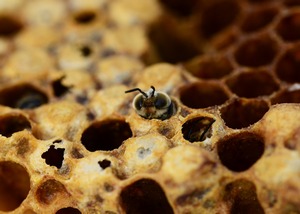A Young Drone

The drone emerging from its cell in the picture began Its life about 24 days ago when the egg was laid. Thus, a drone takes longer to develop into an adult than a worker (20 days) or a queen (16 days). Another way drones are different is that they are male bees. Queens and workers are females and they develop from the same kind of egg — a fertilized egg. This means that a sperm cell (one of millions made by each male drone bee and passed to the queen on her mating flight) has combined with, or fertilized the egg. The eggs that drones develop from do not combine with sperm cells. They are unfertilized. Somehow, scientists do not know how, the queen bee is able to lay unfertilized eggs. Such eggs are laid in drone cells only. In nearby worker cells, she lays fertilized eggs. Drone cells are larger than worker cells and are usually found near the edge of the brood comb. Drone eggs, like worker eggs, hatch in three days. But unlike the workers, drone larvae are fed a special food which appears to be similar to royal jelly. Each day, the larva increases its weight from about 2 to 6 times the previous day’s weight until the tenth day after the egg was laid. At that time, it is full grown. The workers then cap the cell and the larva spins its cocoon and turns into a pupa. When the adult drone sheds its pupal skin, it chews at the cell cap until it makes a hole big enough to get out. This is probably the only time in its life when the drone uses the jaw-like sections of its mouth parts.
This may explain why the drones’ “jaws “are tiny compared with worker bee “jaws”. After it has climbed out of its cell and cleaned its body, the drone rests on the brood comb, receives food from the workers, and waits until it is ready to start mating flights, at about ten days of age.
The number of drones in a bee colony varies from no drones up to several thousand! During the winter there are usually no drones in the colony. The first drones of the year emerge from their cells several weeks after the first workers in early spring. By late spring and during summer, there are usually a thousand or more drones in the hive. The population then gets less and is back to zero by fall.
The number of drones at any one time depends somewhat on how many drone cells there are in the comb. If there are only a few drone cells, only a few drones can be produced. This does not mean that if there are many drone cells the queen will deposit eggs in all of them. An older queen is more likely to lay eggs in drone cells than a younger queen. This means that there tends to be more drones in a colony where the queen is likely to die of old age. Because of this, drones needed to mate with a new queen will be available.
Some scientists think that the number of drones is controlled by the strength of some of the chemical messages (odors or liquid materials) that the queen bee produces. Older queens, according to this theory, produce less strong messages and this causes workers to allow more drones to stay in the colony. Even though queens lay eggs in drone cells and adult drones come out of their cells, the workers may not allow all the drones to stay in the colony.
The Bees section was created with special thanks to Louis Juers (Arizona State Parks & Trails) for providing information used in this section. Additional information and digital materials were obtained from some of the following organizations. We would like to thank them for all their dedication and hard work within their profession.
|









